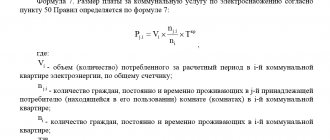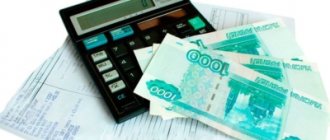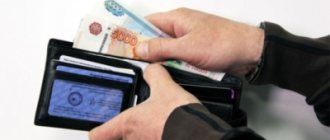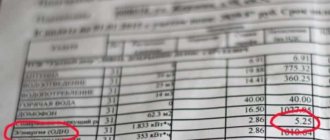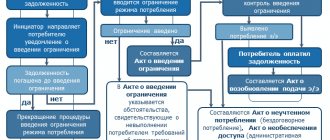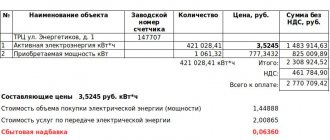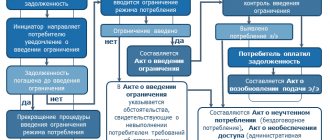“HVS ODN” - decoding
When receiving a monthly payment receipt, the first thing that may confuse you is the abundance of abbreviations that are incomprehensible to someone who has just begun to delve into the details of utility charges.
“HVS ODN” and “DHW ODN” are the consumption of resources for general house needs (GVS) for cold water supply (CWS) and hot water supply (DHW).
As a rule, the consumption of cold water supply exceeds the consumption of hot water. This is due to the fact that cold water is the main water supply in an apartment building, and hot water is obtained by heating cold water and is supplied in the volume that is necessary to obtain the desired temperature.
Heating occurs using heating devices that raise the water temperature to 60-75°C, after which house pumps supply water through pipelines to apartments and other places of household consumption.
Due to the fact that obtaining hot water requires additional resources in the form of heating and supply to apartments, its cost is usually higher than the cost of cold water supply.
Why is there a problem with paying for excess ODN?
The problem lies in the imperfection of legislation and the consumers themselves. Unfortunately, some residents may underestimate their readings or not report them at all, and the accruals made by the management authority may not reflect the actual consumption in their apartments. Therefore, there is a huge difference between the readings of the general meter and the volume of billing services (individual meters). Also, according to Rule 354, the management authority is required to check the accuracy of the submitted evidence, but unfortunately the procedure is so complicated that it is not always possible to get into your “favorite” apartments. From my own experience, I will say that in houses where the meters are located in the entrances, there are no problems with common house meters, since the management office has the ability to control the condition of the meters, their readings, etc.
What is included in the ODN for cold water?
The water tax rate includes the consumption of resources consumed for the maintenance and servicing of the common areas of the house. Such territories include both the interior space (entrances of the house, utility rooms, attics and basements) and the external territory adjacent to the house (yard, parking lot, additional buildings).
A typical example of general house water consumption could be the consumption of water for wet cleaning of entrances or for watering flower beds located on the territory of the house.
Read more about what ODN is
Standards for ODN for electricity in the regions of the Russian Federation
Introduction to peak and other electricity tariff zones
The size of the standard depends on the quality of the electrical equipment of the house and its number of floors. Standards in each region of Russia are set by local authorities. They represent a single value per 1 m2 of area, relating to communal premises and local areas.
The new rules for calculating ODNE practically exclude unauthorized increases in the amount of payment for this expense item. Previously, the management company itself made payments to the energy supply company, but now the costs of ODNE are borne by the apartment owners according to a special line in the receipt. The calculation of this expense item is based on the standard adopted by the regional state administration.
There is no uniform standard for ODNE for MKD across the country. In different territorial entities of the Russian Federation, indicators vary greatly. To calculate ODN, you need to take into account a number of factors:
- number of floors of apartment buildings;
- the presence or absence of an elevator, house electric boiler, pumps, lighting of the local area, etc.;
- whether ODPU (common house metering devices) is installed or not;
- local tariff for ODNE.
Based on these data, a standard is formed, on the basis of which LTNE is calculated in the receipt. Since the beginning of 2019, people have been paying for electricity supply according to regional standards. Now, if electricity consumption is less than the standard, then payment is made based on consumption. Below is a table of standards in some regions and republics of Russia, established by local authorities from 01.01. 2021
Table of standards for ODNE
| Regions | Standard ODN, kW/h per 1 m2 per month | |
| MKD without elevator | MKD with elevator | |
| Moskovskaya (Moscow) | 2,88 | 0,61 |
| Leningradskaya (St. Petersburg) | 1,66 | 0,42 |
| Nizhny Novgorod (Nizhny Novgorod) | 1,6 | 0,39 |
| Sverdlovskaya (Ekaterinburg) | 4,16 | 1,96 |
| Saratovskaya (Saratov) | 2,44 | 1,82 |
| Novosibirsk (Novosibirsk) | 0,973 | 0,728 |
| Lipetskaya | 1,24 | 0,37 |
| Rostovskaya (Rostov-on-Don) | 2,24 | 0,55 |
| Yaroslavskaya (Yaroslavl) | 1,01 | 0,646 |
| Republic of Crimea (Simferopol) | 0,58 | 0,21 |
| Krasnodar region (Krasnodar) | 1,412 | 0,322 |
| Republic of Bashkorstan (Ufa) | 0,791 | 0,295 |
| Republic of Adygea (Maykop) | 1,357 | 0,315 |
Do I need to pay for communal water needs?
ODN for water is paid by apartment owners. Such regulations are prescribed in Government Decree No. 354.
The consumer of utilities in an apartment building, regardless of the chosen method of managing the apartment building, as part of the payment for utility services, separately pays for utilities provided to the consumer in residential or non-residential premises, and for utilities consumed during the use of common property in an apartment building home (hereinafter referred to as utilities provided for general house needs). “Rules for the provision of utility services to owners and users of premises in apartment buildings and residential buildings”, Decree of the Government of the Russian Federation dated May 6, 2011 No. 354
Thus, the accrual of ODT for water is completely legal on the part of the management company.
Evolution of ODN. Why common house payments have become a concern for management companies
The Barnaul city power grid no longer charges “ONE”. Energy companies sent out the relevant agreements en masse to management companies and homeowners associations. From April 1, the service will be finally integrated into the payments of housing organizations as a “municipal resource for the maintenance of common property” (KR on SOI). The line “ONE” in BGES receipts will be seen only by those who at one time accumulated debts for it, and by residents of houses with a direct form of government. Oksana Puchkina, head of the group for work with debtors of the Department for Sales of Electricity to Legal Entities of BGES, explained what the reform of payments for common household needs is connected with.
About the evolution of ODN
Oksana Nikolaevna, I remember that ODN was not always in our receipts, how and when did this service appear in our payments and how was it integrated into the Kyrgyz Republic on SOI?
The starting point can be considered the adoption in September 2012 of Government Resolution No. 354, namely the “Rules for the provision of utility services in an apartment building.” After this, “Electricity supply for general house needs” appeared in the receipts of the Barnaul city electrical network. It would be untrue to say that residents previously did not pay for common house needs. “ONE” existed, but in a truncated version. In the form of electricity meters for common areas, MOPs that did not cover the electricity consumption of the entire house, including non-residential premises attached to the house (shops, garages, kiosks, etc.). Accordingly, it was more difficult to identify energy theft, the resource was not fully taken into account, and energy workers suffered losses. It was precisely in order to teach consumers how to count electricity that “ONE” was created. The replacement of settlements under MOP with settlements for ODN at one time caused a wave of indignation. However, the political course of the state was taken towards energy saving and Law No. 261 “On Energy Saving” was adopted even before the “ODN”, in 2009. We gradually learned to save everywhere - in production, in budgetary institutions and, finally, in apartment buildings. In 2021, “ODN” was transferred from utility services to housing services. In simple words, they took it from the resource officers and gave it to the managers. Charges were limited to the standard, and the entire difference between the readings of the common house meter and the standard was assigned to housing organizations. Thus, the “evolution of one resource” took place, first we learned to count the resource, now we are learning to save it.
About energy saving lessons
Why is the Barnaul city power grid now massively refusing to charge for single use electricity supply?
In the system of payments for general household needs, the Barnaul city electric grid has become an extra link. Judge for yourself. We cannot go into an apartment building and, in order to save energy, install energy-efficient equipment or repair dilapidated networks. This is the task of housing organizations, namely management companies or HOAs. Therefore, the state, through a series of legal acts, excluded resource workers from this chain. A simple example. Remember Barnaul 10-15 years ago, walking down the street in the dark you could see the lights on in the houses on the landings around the clock. After the adoption of the law “On Energy Saving” and after the ODN appeared, management companies started thinking about saving and motion sensors appeared in our entrances. Then, in 2014, the country began a wave of major renovations in the old housing stock, with the state taking on the majority of the costs. One of the main directions of this repair campaign was the replacement of intra-house utility networks - electrical, water, gas supply. The Law “On Energy Saving” proclaims one of the main, in my opinion, principles – “support and stimulation of energy saving, increasing energy efficiency.” This is the basis and the answer to the question why the Kyrgyz Republic appeared on SOI and why the Barnaul city electric grid can no longer charge the ODN service.
About the third wheel
— Do management companies no longer have a choice? Can they pay for common household needs according to the old scheme, that is, leave one unit in their houses?
Regulatory legal acts provide for the procedure for maintaining common property; the obligation to pay for it is provided for in Article 156 of the Housing Code of the Russian Federation. Thus, residents are required to pay not only for electricity and other resources consumed in the apartment, but also for those spent on the needs of the house. In turn, Government Resolution No. 354 (namely paragraphs 63 and 64) states that the management company is obliged to purchase electricity, water, and heat from resource providers for the maintenance of common property. Management companies or HOAs do not have the right to refuse to conclude such an agreement. For some time, the Barnaul city electric grid did not force management companies to enter into contracts. In a word, everything was left to the goodwill of housing organizations. However, time passed and management companies did not show much zeal to take responsibility for settlements under ODN. I will say that since the beginning of this year the social mission of the Barnaul city power grid has been completed. Agreements will be concluded voluntarily or compulsorily. The Barnaul City Electric Network has already sent a package of documents to all housing organizations and after 30 days, regardless of whether the management company signs it or not, the contract will be considered concluded. By the way, the signing of the agreement itself is not a stumbling block, because the formal procedure has been followed. The agreement has been prepared and sent to the management company or to the HOA. There is judicial practice according to which physical signing of a contract is not mandatory. The very fact of resource consumption is confirmation that the Management Company is responsible to the resource supply company for paying for electricity. This position was confirmed in the Supreme Court of the Russian Federation.
About the intricacies of calculations
Tell me, will there remain one for a certain category of houses?
The very definition of one-way service has not disappeared from the legislation. As before, residents of houses with a direct form of government and houses where the method of management has not yet been determined have received and will continue to receive receipts for ODN. In this case, we provide the utility service ODN directly to the owners and its calculation is carried out using a common house meter.
Isn’t “ONE” or “KR on SOI” limited by the standard?
When an apartment building has a housing organization servicing it, be it a management company or an HOA, payments for general building needs are always limited to the standard. The settlement scheme is as follows: the management company or homeowners' association pays the Barnaul city power grid using a common building meter, but residents can be charged amounts only within the standard. We didn’t meet the standard, which means there are losses. The excess difference can be paid by residents only if such a decision is made by the general meeting of owners.
About the size of the standard
In 2021, there was a fuss about the approved standards for communal resources for the maintenance of common property. In particular, the position of BGES was that the standards were calculated incorrectly. Have the standards been recalculated now?
The history of the adoption of standards is quite long. Until 2021, at the state level, they developed a methodology for calculating standards, then imposed a moratorium on charges according to standards. Currently, the region has a standard adopted by the Decision of the Tariff Administration of the Altai Territory dated November 16, 2021. When approving the standards, BGES and other regional energy companies were asked for information on the area of common areas in apartment buildings, but no one, including BGES, had reliable data at that time. For many management companies, the technical documentation for the house was lost, and no one knew what this value actually was. We went to the courts and forced housing organizations to provide correct data, confirmed by the technical passport for the apartment building. As a result, according to the technical documentation, it turned out that the area of common areas in the houses differed significantly from the information that the management company and the HOA provided us. At one time, the Barnaul city power grid spoke about this, one might say, warned. However, we got what we have now. We cannot say whether the standard is high or low, this standard is what it is, and management companies are obliged to work according to it.
About the distribution of roles
— Management companies do not have the money to pay the excess difference and their position is logical and understandable.
There is always a way out. If the management company or the homeowners association explains to the residents why the electricity consumption in their home cannot be included in the standard, at the general meeting an absolutely legitimate decision can be made - to pay for the Kyrgyz Republic on the SOI according to the general building meter. However, for this, management companies and homeowners associations need to take the reins into their own hands and start working with residents, which many do not want to do. This possibility is provided for by law, and we know a large number of houses where this payment system is successfully used.
Is excess standard the only reason why management companies do not want to allocate resources for the maintenance of common property?
Accruals for ODN or CD on SOI are always labor-intensive work. We accrue the Criminal Code using a common building meter, and the Criminal Code, in turn, must make an accrual for each owner of an apartment building. Responsibility arises for each calculated figure. When the Barnaul City Electric Network charged residents, we bore this responsibility, but the management companies had to bear it, which was very convenient for them. In case of incorrect accrual, sanctions from regulatory authorities were imposed on BGES, but not on the Criminal Code. In addition, all expenses for settlements and debt collection were also not profitable for management companies. It was much easier to do this with the help of power engineers, but the legislator distributed roles, responsibilities and responsibilities differently.
In any case, the money should go to the Barnaul city power grid. Aren't you afraid that by outsourcing the service to management companies, they will not work conscientiously with residents in terms of collecting money, and receivables will only increase?
The Barnaul City Electric Network has no choice; we are obliged to act in accordance with the law. Certain legal conflicts arose in the issue of concluding an agreement with management companies for the supply of resources for the maintenance of common property. In particular, it was not entirely clear how to act if the management company refuses such an agreement. It was not clear how charges would be made to residents for general house needs without a contract. How will we ultimately receive money for the supplied electricity without a contract and whether we will receive it at all? BGES wrote letters to the Russian Ministry of Construction, but we did not receive a clear answer from them either. The Supreme Court of the Russian Federation finally put an end to this dispute. In his decision, he decided that the contract may not be signed by the parties, but the resource supply company is obliged to supply a resource on SOI to the apartment building, and the management company is obliged to pay for it. Understanding that many management companies and homeowners associations are not ready for such a redistribution of responsibilities, we agreed to meet them. Today BGES proposes to conclude an agreement for the provision of services; according to its terms, the Barnaul City Electric Network makes payments to the owners of apartment buildings, collects funds, and, if necessary, collects debts. In fact, under this agreement we carry out all the actions that the management company should do.
How is ODN calculated for water?
Unlike apartments, common areas are not equipped with individual metering devices (IMU), and therefore water consumption for common house needs is recorded only by a common building meter (ODMU).
When calculating the ODN payment for water in an apartment building, the readings of the common building meter are first taken. It shows how much total water was consumed within the home during the reporting period.
Next, the readings of the residents’ individual metering devices are collected and summarized. In order for the house balance to be compiled correctly, the IPU readings must be taken at the same time.
Typically, several days are allotted for collecting readings from residents, but today manual collection of readings is increasingly giving way to automated collection of readings, which makes the collection process as one-time as possible, which increases the accuracy of the balance for the house.
Unlike manual reading collection, which takes a week to collect and process all the readings, automated reading collection allows you to consolidate your home data in just 15 minutes.
After the IPU readings are collected, their amount is subtracted from the readings of the general building meter. The difference that results is usually considered an expense for general household needs.
A simple example: a communal meter showed the consumption of 4,000 m³ of water during the reporting period. The total readings from individual metering devices amounted to 3,800 m³. The resulting difference of 200 m³ is the amount of water that was spent on the maintenance and maintenance of common areas - for wet cleaning in the entrance, watering the flower beds on the territory, etc.
Question
It is still not completely clear to me who will pay for the cost of one-time tax in excess of the norm.
We were in compliance with the standards, and indeed, at the top of our payroll were the standards established by the state. However, everything that dripped in excess of the norm was still deducted from the house account. Those. as if these payments were not in the payment slip, but at the end of the year, the management company’s report included an item for one-time taxation, where there was not a word about the standards, but the entire one-time tax for the year, which was accordingly debited from the house’s account. Please comment on this issue with reference to specific documents, with which you can then come to the Criminal Code to prove your case. This issue has already been partially discussed in the article “How are general household needs calculated and should there be recalculations at the end of the year.”
If the volume of one is negative
A negative value of one tax for electricity is added up if the general building meter records the consumed volume of electricity less than the summed readings of apartment meters. This is due to the lack of electricity meters for several homeowners who pay ODNE according to the standard.
The electricity supply company compensates for the negative balance by recalculation, based on the number of residents or the total area of each apartment. This system for calculating ODN for electricity is approved by Article No. 354 of the Government Decree.
Example of calculating a negative balance
Over the course of a month, the difference between the data from ODPU and all MKD electricity meters was 150 kW/hour. The number of residents is 200 people. The difference is distributed per 1 person: 150/200 = 0.75 kW/h. The result obtained is multiplied by the number of residents of each apartment. If 3 people live in it, and the current electricity consumption is 150 kW/h, then 150 will be counted: (0.75 x 3) = 147.75 kW/h.
Examples of calculating the ODN of a multi-storey building
There are two formulas for calculating how to pay for one electricity supply. One of them is an option for calculating ODN without a common house electricity meter.
Without counter
Calculate the amount of energy spent on one unit without a meter using the formula:
Viodn = N one x Soi (Si/Sob),
Where:
- N one – consumption rate established by local authorities;
- Soi – communal area;
- Si – apartment area;
- Sob – the entire area of the house.
The management company, which has calculated the amount of energy, multiplies it by the tariff.
With counter
The second formula for calculating ODN for electricity is based on the readings of a common house electricity meter:
Vi = (V d – V tender – V core b – V core – V cr),
Where:
- V d – readings of the common house meter;
- V nezh – electricity consumption in communal premises;
- V lived b – consumption in apartments without an electric meter:
- V lived - the same with the counter;
- V cr – electricity consumption for additional services.
Important! Whether it is necessary to install a common house electricity meter will be shown by a comparative analysis of the costs of one electricity meter if it is present or not. The result will always be in favor of installing a common house meter.
Testimony must be submitted on time
What to do if there is no meter
In the absence of a general electricity meter in the apartment building, the calculation of ODN is carried out in accordance with the approved new standards. The calculation formula looks like this:
Vodn = Nodn xSoi x (Sq/Sob),
Where:
- Vodn – electricity consumption in the apartment;
- Nodn – standard for 1 m2 of MKD area;
- Soi – common house area;
- Sq – apartment area;
- Sob – the sum of the areas of all apartments.
Having determined the share of ODN of each home owner, the management administration adds it to the data of the electric meter, if there is one. When there is no device, the share is added to the standard, which is reflected in a separate line of the ODN receipt.
How to calculate ODNE in MKD using a meter
Homeowners in apartment buildings are often interested in how to calculate the ODN on their own. The calculation is simple. The total area of the apartment building, including communal areas and apartments, is taken as a basis. The established tariff of a specific region is entered into the calculation. The readings of the ODPU and individual electricity meters are taken into account.
If there is no communal meter in the apartment building, then the calculation is carried out according to another option. Below are examples of calculations of ODN for electricity.
Example of calculating ODN
Who can change the meter on the landing from 2021
In apartment buildings, apartment electricity meters are placed in panel cabinets on staircase landings. Over time, electricity meters may break down. Such a meter is replaced by an electrician from the management administration. The specialist has the rights to inspect, install and repair electrical control equipment.
The owner of the home, having noticed a breakdown of the meter or a damaged seal, is obliged to urgently inform the management company about this. The master of this organization will dismantle the old device, install a new electric meter and seal it.
The electrician must be certified and have permission to carry out repair work on electrical equipment of the MKD. This is evidenced by the fact that the electrician has the appropriate certificate.
Note! If the meter is considered an appliance for individual use, then all costs for restoring the power supply to the apartment are borne by its owner. If the housing is listed as municipal property, then the replacement of the electric meter is carried out at the expense of the municipality.
Which is more profitable: with or without a meter?
Practice shows that significant savings in energy costs come from installing electric meters. Calculations without a meter include a large reserve of excess electricity consumption.
If the apartment does not have a meter, then the owner of the apartment building needs to contact the energy supply company, for which a corresponding agreement is concluded. The owner of the apartment can purchase an electric meter himself or use the services of an electricity supplier.
The purchased model of the metering device must be certified by the manufacturer, which is confirmed by the accompanying documentation - the product passport. After contacting the management company with an application to install an electric current consumption meter, a decision is made to call an electrician.
Before installation, the debt for payment for electricity is paid off. The new meter has zero readings. If there is any data on the display, this is noted in a special document.
Video
Coffee capsules Nescafe Dolce Gusto Cappuccino, 8 servings (16 capsules)
435 ₽ More details
Coffee capsule Nescafe Dolce Gusto Cafe O Le Coffee with milk, 3 packs of 16 capsules each
1305 ₽ More details
LCD TVs

